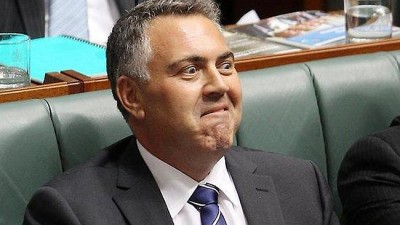How to pay for a war

The Treasurer said if Mr Shorten was “honest” about his promise of
bi-partisan support for Australia’s mission in Iraq, he would pass
budget measures currently stalled in Parliament. Is he suggesting
that sick people, pensioners, students and the unemployed should fund
the war?
I have a suggestion.
When Joe Hockey produced his first fiscal statement in December last
year, the deficit over the forward estimates had grown from $54.6
billion in August’s PEFO to $123 billion.
Part of this was due to Joe spending an extra $11 billion in his
first 100 days as Treasurer, the most significant payment being the
unasked for $8.8 billion gift to the RBA.
But the greatest increases to the deficit (and future debt) came from
just changing forecasts. Hockey told us that Labor’s predicitions were
unrealistically optimistic, despite the independent PEFO coming up with
the same figures.
In almost every parameter, Hockey lowered PEFO forecasts, often
dramatically, for the performance of the Australian economy . He
insisted on the worst possible forecasts in order to exaggerate the
“mess” he inherited.
Real GDP forecasts from PEFO were 2.5% and 3%, written down in MYEFO to 2.5% and 2.5% for the years 2013-14 and 2014-15.
The quarterly national accounts figures show the trend annual real
GDP growth of 3.2% which is right on the 25-year average and
significantly higher than predicted in either PEFO or MYEFO.
The IMF expects the Australian economy to grow by 2.8 per cent in 2014 and 2.9 per cent in 2015.
As for nominal GDP, PEFO predicted 3.75% and 4.5% – Hockey’s MYEFO 3.5% and 3.5%.
He decreased nominal GDP forecasts to their lowest level since the
global financial crisis. This has a massive impact on revenues, which
are very sensitive to changes in nominal GDP growth. This had the effect
of reducing projected revenue over the forward estimates to $51 billion
less than projected in PEFO.
In fact our annual nominal GDP rose by 4%. This is less than the
25-year average of 6.1% but once again, significantly higher than
predicted by Hockey and even higher than PEFO.
Joe’s predictions about construction were even worse.
In MYEFO, housing construction growth was reduced to only 3% rather than 5% as forecast in PEFO.
Private dwelling investment actually increased 3.2% in the June
quarter and 9.5% in the past year, the strongest pace of growth recorded
in the Housing Industry Association Performance of Construction Index
nine-year history.
As these few examples have shown, and as was muttered at the time (or
shouted loudly by some of us), Hockey’s predictions were unnecessarily
pessimistic in an obvious attempt to artificially create the debt and
deficit disaster you have when you aren’t having a debt and deficit
disaster.
Change a couple of assumptions and hey presto, we’re rolling in money. Bombs away.
Speaking of which, did you hear that the ADF just threw away $400 million worth of missiles that don’t fit their new planes?
You wanna talk waste, start with a group who plan that badly.

No comments:
Post a Comment